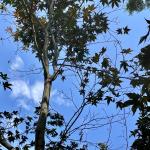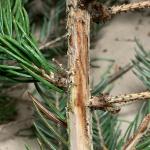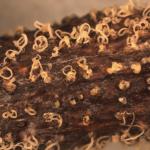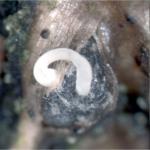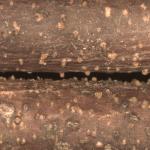Phomopsis Canker
Pathogen
Several species of Phomopsis (syn. Diaporthe) cause cankers of stems, branches and occasionally the main trunk of trees and shrubs in forest and landscape settings.
Hosts
Due to the many species of Phomopsis present in the region, a wide array of conifers and hardwoods in forest and landscape settings are susceptible to infection. Commonly affected landscape hosts include: Holly and inkberry (Ilex), boxwood (Buxus), privet (Ligustrum), viburnum (Viburnum), Japanese maple (Acer palmatum), elm (Ulmus), flowering cherry (Prunus), crabapple/apple (Malus), dogwood (Cornus), blue and Norway spruce (Picea pungens and P. abies), juniper (Juniperus), eastern hemlock (Tsuga canadensis), eastern white pine (Pinus strobus), fir (Abies), umbrella pine (Sciadopytis), and yew (Taxus).
Symptoms & Signs
Phomopsis typically becomes established on current year's shoots, or it invades stressed and weakened plant parts through some type of wound (i.e. a canker, pruning wound and insect feeding site). However, Phomopsis can also gain entry through buds and progress down the stem. Primary symptoms of infection include wilting leaves, blight of young shoots, sunken and darkened areas of stems with possible sap or resin flow, cankering on larger stems and branches, browning of the vascular tissue when bark is scraped away, and canopy dieback. However, in many cases there are no symptoms of infection aside from leaf wilting and canopy dieback, making it difficult to identify Phomopsis as the causal agent.
Phomopsis will sometimes attack larger branches (>4” in diameter) and the main trunk of shrubs and small trees, but it most often attacks small diameter stems, resulting in sporadic crown dieback. The pathogen is more common on trees and shrubs with thin bark and dense canopies where shade and free moisture linger. Depending on the host and species of Phomopsis present, fruit rot, leaf spots and a foliar blight can also occur. Foliar infections most often take place on broadleaved evergreens, such a rhododendron. Numerous stresses common in landscape settings can facilitate infection, such as transplant shock, physical or mechanical injury, freeze injury, insect feeding and excessive pruning. After Phomopsis has established within the host, it produces an abundance of small, black-colored pads of tissue that erupt through the bark to release cream-colored spore tendrils. The spores are washed down or blown onto nearby stems, creating new infection centers. By themselves, the resulting cankers may do little damage but are produced in such large numbers they often girdle stems and branches. Many otherwise healthy woody plants may harbor a minor infection in the canopy that can go undetected until the tree is stressed.
Management
Most often, there are underlying stresses that have facilitated disease development that may need to be addressed if Phomopsis is to be successfully controlled. If possible, prune and discard all blighted stems and branches from the canopy. Avoid pruning during prolonged wet periods as this can spread the pathogen. Sanitize pruning tools after working with plants that are known, or suspected of being, infected by Phomopsis. The fungus will continue to produce spores throughout the growing season, making it challenging to control once established. However, with regular pruning and removal of dead tissues, a significant volume of inoculum can be removed from the plant. Fungicides may be effective at protecting new shoots in the spring, when young and tender shoots are most susceptible to infection. Keep in mind that spores travel very long distances and Phomopsis is common in the environment. Fungicides labeled for use against Phomopsis include: azoxystrobin, carbendazim+debacarb (microinjections), copper sulfate, copper hydroxide, copper salts of fatty and rosin acids, mancozeb, metconazole, thiophanate-methyl and trifloxystrobin.
